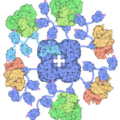Assisted reproductive technologies (ART) have grown in popularity and success over the recent decade. According to the CDC, in 2011 there were 61,610 babies born via ART, representing 1% of the US newborn population, nearly doubling ART use in just one decade. ART can be a blessing for the nearly 6% of US couples struggling with fertility issues. In the 30 years since ART began, there have been over 3.5 million children conceived using ART, many of whom are now adults of reproductive age. One wonders, what long-term, transgenerational effects might exist from ART; will those conceived via an assisted reproductive technology, also require reproductive assistance? Are the rates of cancer, especially reproductive cancers and hormone dependent cancers known to be epigenetic in nature, increased? Each of these questions remains to be addressed fully, but here is what is known so far.
The Basics – What is ART?
Assisted reproductive technologies refer to the techniques used to bring sperm and egg together in order to achieve pregnancy. The methods of assisted reproductive technologies include: in vitro fertilization – embryo transfer (IVF-ET), gamete intrafallopian transfer (GIFT), zygote intra-fallopian transfer (ZIFT), and frozen embryo transfer (FET). By far the most common is IVF- ET with fully 99% of couples using this method of assisted reproductive technology. IVF begins with intense hormone treatment to stimulate maternal oocyte production. Those eggs are removed and fertilized with the donor or partner’s sperm. In most cases, eggs and sperm are placed in a petri dish and allowed to mix freely. In some cases, additional manipulation is required and the sperm is injected into the egg. This is called intracytoplasmic sperm injection or ICSI. IVF plus ICSI appears to account for a large subset of the birth defects associated with IVF.
Early Indicators of Birth Defects with Assisted Reproductive Technologies
A 2007 study of California couples found that children conceived using ART, especially those conceived with ICSI, had a 35% increase in risk for birth defects compared to those conceived naturally. Most common among them were eye abnormalities, heart defects and malformations of the genitourinary tract. Other studies have linked ART to an increased risk major structural malformations of the heart, cleft lip and palate, esophogeal atresia (the esophogus dead-ends in a pouch rather than into the stomach where it should be) and anorecto atresia – (a malformed anal opening).
Among the few studies addressing birth defects and developmental anomalies post infancy, a Chinese study found an increase in observed birth defects in ART males as time progressed, compared to females and compared to those observed at birth. In fact the rate of observed birth defects doubled over the course of the 3 years. Similarly, a study looking at one year olds conceived via ART found a doubling of the rate of multiple major birth defects including chromosomal and musculoskeletal defects.
Long Term Consequences of ART
Studies looking at longer-term difficulties, whether health or developmentally related are few and have had mixed results, always ending with the caveat that it is unclear whether the assisted reproductive technology or the original infertility itself was to blame for the defect. There does seem to be a near doubling of the risk of some rare cancers children conceived via ART, but again the data sets are small and the risk of theses cancers in general is low.
A more recent study compared cardiac function between children and young adults conceived naturally versus those conceived with ART. What they found was striking. The apparently healthy individuals with no visible malformations who were conceived by ART had significant decreases in cardiac and pulmonary functioning by a number of parameters. There was marked vascular dysfunction of the systemic and pulmonary circulation, to which the authors of the study suggest may lead to premature cardiac morbidity at a rate similar to rates seen in type 1 diabetes.
ART and Imprinting Errors
A number of ART epigenetic studies published have assessed the risk or rate of what are called imprinting errors. Imprinting errors occur when genes are incorrectly silenced. A individual normally gets one active imprinted gene, either from mom or dad. When errors occur, they may get two active or two inactive copies. Children born from assisted reproductive technologies have an increased risk of imprinting errors compared to the rest of the population. The common conditions that arise include:
- Beckwith – Wiedmann Syndrome – an overgrowth syndrome where children are larger than normal
- Angelman Syndrome – characterized by severe developmental disability and seizures
- Prader -Willi – a syndrome characterized by short stature, developmental delay, and compulsive eating
As with the some of the other birth defects observed with ART, those using ICSI – the forcible injection of the sperm into the egg, seem to proffer higher risks and seem to affect males more than females (or perhaps, as is the case with most research, it is the male offspring that are studied more frequently). Of note, the combination of ICSI and environmental endocrine disrupting chemical exposures is linked to trends in demasculization and potential sterility.
Epigenetics and Assisted Reproductive Technologies
Thus far the notion of epigenetic changes in children conceived via assisted reproductive technologies has been limited to research on the aforementioned imprinting errors, also called epimutations. Research on the broader consequences ART, particularly in general health and reproductive health is lacking. The exposure to hyper hormonal states common in many assisted reproductive technologies has the possibility of disrupting critical hormone pathways across the lifespan of the offspring and may impact his/her reproductive health in subtle, and not so subtle, ways. Some effects may not appear until much later in life and certainly there is the possibility of transgenerational changes as those observed with DES, dexamethasone and other hormone exposures during embryonic and fetal development. Additionally, as evidenced by the study on cardiac-pulmonary function, it is conceivable that many of the epigenetic effects will be functional in nature versus more obvious structural malformations. However, because ART bypasses the natural buffers in human reproduction that might have otherwise selected out for specific traits, it is difficult to disentangle native ‘deficits’ – those of the mom and dad – versus those directly linked to the procedure itself. Only time will tell what the effects of ART are on the health and functioning of subsequent generations.













